Being recognized, staying top of mind, taking the leadership role, being perceived as reliable, maintaining or building your reputation as a favorite supplier… all of these are objectives of branding.
Why would PepsiCo and Coca-Cola invest $4 billion per year in brand advertising(1) from 2015 to 2018 if it wasn’t worth it?
Brand advertising is necessary groundwork to build a solid business foundation and influence your buyer’s journey even before they set foot into material selection.
For quite some time at SpecialChem, we were curious to measure the impact of branding on new business, so we collected relevant data over the course of one year specifically for the specialty chemical industry.
This included data from analysis of both our traffic and the lead generation performance of our digital marketing programs run on our 5 Material Selection Platforms.
Let’s have a look to our findings!
Popularity Index: your popularity on a comparative scale
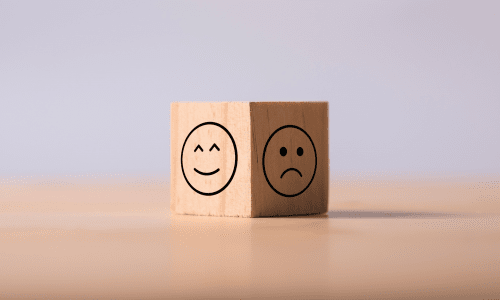 Before deep diving into the results, we need to introduce a concept. The Popularity Index.
Before deep diving into the results, we need to introduce a concept. The Popularity Index.
Warning: As true data scientists, we are going to detail how we are calculating this index. If you are allergic to math, click here to skip it.
For a given period and Ingredient Selector, the Popularity Index of a chemical supplier X is:
Popularity Index (Supplier X) = % of Product views of Supplier X on total Product views in Selector / % of products in Selector associated to Supplier X on total number of products in Selector
Let’s take a quick example with only 2 suppliers:
| |
Supplier A |
Supplier B |
All suppliers |
| Nbr of listed products |
2 |
4 |
6 |
| Nbr of product views |
100 |
20 |
120 |
| Popularity Index |
(100/120) / (2/6) = 2.5 |
(20/120) / (4/20) = 0.25 |
|
The math storm is over. You are safe now.
So, how to interpret this index?
- Popularity index ABOVE 1: the popularity index means that your brand is popular. In average, your products are seen more frequently than the average of our entire product database.
- Popularity index BELOW 1: this is a red alert. Your brand is less popular than the average (or even not popular at all).
- Popularity index EQUAL to 1: this index indicates that your brand popularity is within the industry average.
Using this index allows us to remove the absolute popularity of a supplier – meaning its total traffic size — from the equation.
This way, we are able to compare the relative popularity of a worldwide leader like BASF or Covestro to a medium-sized company having far less products and absolute traffic consequently.
By the way, you can contact us if you are curious to know your company’s popularity index.
This concept being clarified, let’s have a look to the learnings.
Popular suppliers generate 3x more leads
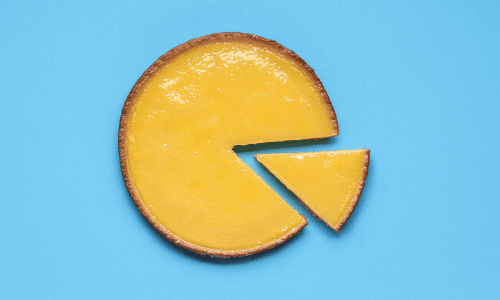 During 12 months, we compared the lead generation performance of 68 digital programs run on SpecialChem platforms, and we grouped those programs into 2 categories.
During 12 months, we compared the lead generation performance of 68 digital programs run on SpecialChem platforms, and we grouped those programs into 2 categories.
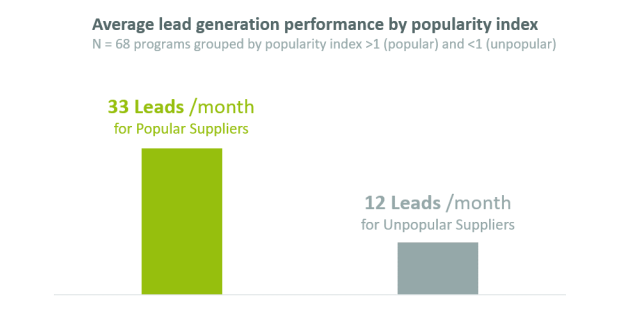
It’s no surprise that the more popular suppliers generate more leads in average.
But the most interesting part is the difference between each category.
Popular suppliers drive approximately 3 times more leads from their products with 33 leads per month in average. On the other side, less popular suppliers generate 12 leads per month.
Important note: Those average numbers are not and cannot be used as industry benchmarks. Don’t compare your performance to the average 33 or 12 leads per month to determine your popularity, it doesn’t make any sense. Your lead generation performance depends on various criteria such as your company’s popularity, the number of listed products and the type of products for example.
Advertising website banners increased popularity for 3 months, with a peak at 300%
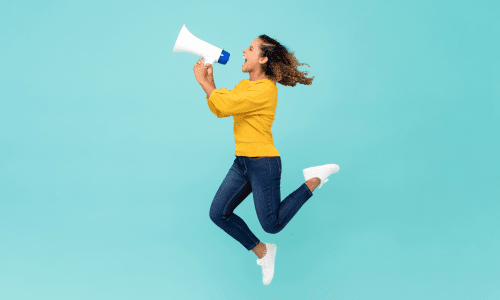 We’ve just seen that being popular leads to higher lead generation performance.
We’ve just seen that being popular leads to higher lead generation performance.
But how can you increase your popularity index?
There is no mystery in this question. Brand advertising campaigns are the most effective way to become popular.
In the course of the 68 digital programs, we promoted each of their brands with a Leaderboard Banner on SpecialChem platforms for one month.
The objective was to measure the impact of a mass-visibility campaign. Just for your reference, our leaderboard banners generate from 40,000 to 100,000 prints per month, depending on the platform.
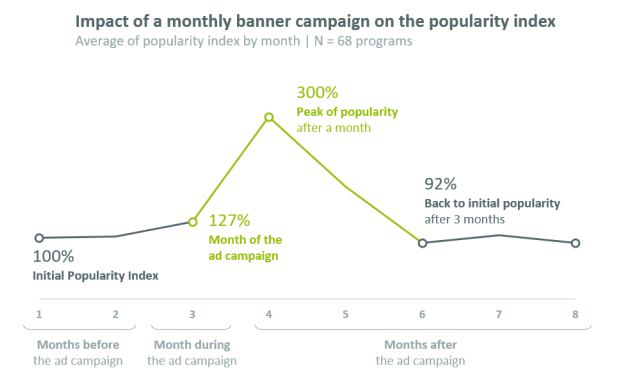 First, we see that the banner campaign has a significant impact on a supplier’s popularity for 3 months.
First, we see that the banner campaign has a significant impact on a supplier’s popularity for 3 months.
During the promotion, we measured a +27% increase in the Popularity Index, but the most impressive was the massive increase during the next 2 months of the banner campaign, with a huge peak at 300%.
After that period, the popularity went back to its initial level.
Branding: from the ugly duckling to the beautiful swan
 Because there is no direct connection from branding to sales in the world of specialty chemicals, measuring the ROI of a brand advertising campaign is tricky.
Because there is no direct connection from branding to sales in the world of specialty chemicals, measuring the ROI of a brand advertising campaign is tricky.
This is certainly the number one reason why so many business developers put advertising aside and consider it as an expense, admittedly necessary, yet reduced to its bare minimum.
Our analysis has clearly shown that advertising campaigns are a must to gain brand popularity — a status that is directly correlated to your lead generation performance.
Source:
(1) https://statstic.com/a-comparison-of-coca-cola-and-pepsis-advertising-expenses/
 Before deep diving into the results, we need to introduce a concept. The Popularity Index.
Before deep diving into the results, we need to introduce a concept. The Popularity Index. During 12 months, we compared the lead generation performance of 68 digital programs run on SpecialChem platforms, and we grouped those programs into 2 categories.
During 12 months, we compared the lead generation performance of 68 digital programs run on SpecialChem platforms, and we grouped those programs into 2 categories.
 We’ve just seen that being popular leads to higher lead generation performance.
We’ve just seen that being popular leads to higher lead generation performance. First, we see that the banner campaign has a significant impact on a supplier’s popularity for 3 months.
First, we see that the banner campaign has a significant impact on a supplier’s popularity for 3 months. Because there is no direct connection from branding to sales in the world of specialty chemicals, measuring the ROI of a brand advertising campaign is tricky.
Because there is no direct connection from branding to sales in the world of specialty chemicals, measuring the ROI of a brand advertising campaign is tricky.